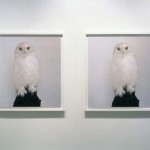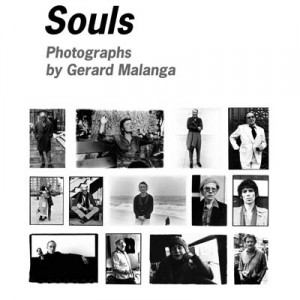Roni Horn AKA Roni Horn is a must-see restrospective by painter/photographer/sculptor/poet named…you guessed it: “Roni Horn.”
 At Boston’s Institute of Contemporary Art, the show, the first to compile such a large body of her work, explores the changing nature of identity and perception.
At Boston’s Institute of Contemporary Art, the show, the first to compile such a large body of her work, explores the changing nature of identity and perception.
In several galleries, the show does so through photographic portraits of the artist and others at different stages of life.
On the ICA’s first floor, photographs of the artist juxtapose images of her looking traditionally masculine with others in which she appears “traditionally feminine–” from early childhood to the present.
On the fourth floor, large portaits of her niece, also taken at different ages, show slightly different expressions, moods, attitudes– are repeated, Warhol-like, in photo after photo.

Another gallery features pairs of seemingly identical photos of the heads and necks of owls and other birds taken from behind.
Yet another includes two identical? photos of a white owl on a black perch.

Dead Owl, 1998
An ICA brochure explains that many of Horne’s works are “composed as pairs, series or with multiple sides, inviting us to notice subtle yet infinte difference between their parts. ”
I was particularly intrigued and impressed with Horn’s large format photographs of water in nature–roiling, calm, on rocks, with glints of sun–many taken of London’s River Thames–and Horn’s accompanying poetic commentary on the changing nature of water and our perception of it.

Still Water, 1999
The “water” gallery also includes two glass sculptures–one largely clear and white, the other mostly black–which, at times, appear to be receptacles filled with water but have surfaces that seem to change shape.
Through a doorway in this gallery, the viewer can see out onto the water in Boston Harbor–highlighting all the more our involvement in/relation to/changing perception of the substance that is part and parcel of our existence–but can also destroy us.
I also enjoyed Horn’s colorful glass sculptures–one, entitled “Pink Tons” , is the largest chunk of glass ever cast; the other, a red hassock-like piece with a squished-in corner that reminded me of a gigantic “gummy bear.”

Pink Tons
Both appeared to change in form and texture depending on the viewer’s vantage point.
“Peer over the top of Pink Tons’ opaque cast sides into a seemingly liquid center that reacts to the atomsospheric changes of Boston’s light and weather. This five-ton glass cube is at once imposing and inviting, brutish yet pink, ” the brochure explains.
“Integrating difference is the basis of identity, not the exclusion of it,” Horn writes. “You are this and this and that….”
Not only is each work beautiful and provocative in itself–but the show as a whole, which integrates a multitude of media and art forms, is a brilliant expression encorporating the artist’s multiple talents and perceptions –and our own.
—Anita M. Harris
New Cambridge Observer is a publication of the Harris Communications Group. We also publish HarrisCom Blog and Ithaca Diaries Blog.
 At Boston’s
At Boston’s 








